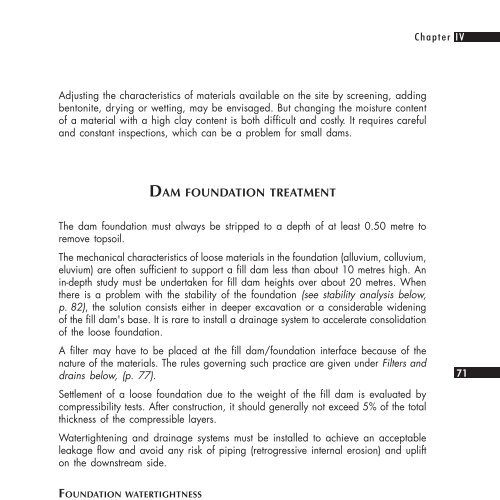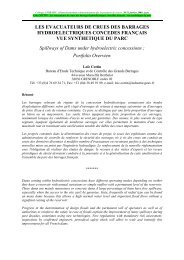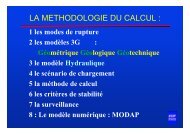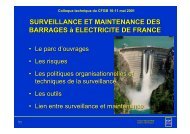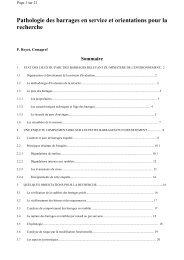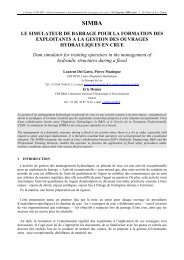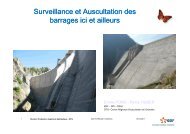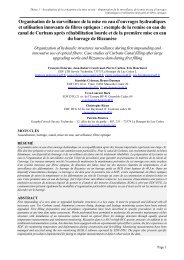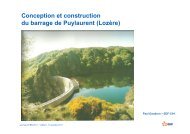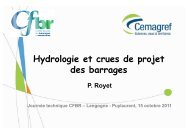SMALL DAMS
SMALL DAMS - Comité Français des Barrages et Réservoirs
SMALL DAMS - Comité Français des Barrages et Réservoirs
- No tags were found...
Create successful ePaper yourself
Turn your PDF publications into a flip-book with our unique Google optimized e-Paper software.
Chapter IV<br />
Adjusting the characteristics of materials available on the site by screening, adding<br />
bentonite, drying or wetting, may be envisaged. But changing the moisture content<br />
of a material with a high clay content is both difficult and costly. It requires careful<br />
and constant inspections, which can be a problem for small dams.<br />
DAM FOUNDATION TREATMENT<br />
The dam foundation must always be stripped to a depth of at least 0.50 metre to<br />
remove topsoil.<br />
The mechanical characteristics of loose materials in the foundation (alluvium, colluvium,<br />
eluvium) are often sufficient to support a fill dam less than about 10 metres high. An<br />
in-depth study must be undertaken for fill dam heights over about 20 metres. When<br />
there is a problem with the stability of the foundation (see stability analysis below,<br />
p. 82), the solution consists either in deeper excavation or a considerable widening<br />
of the fill dam's base. It is rare to install a drainage system to accelerate consolidation<br />
of the loose foundation.<br />
A filter may have to be placed at the fill dam/foundation interface because of the<br />
nature of the materials. The rules governing such practice are given under Filters and<br />
drains below, (p. 77).<br />
Settlement of a loose foundation due to the weight of the fill dam is evaluated by<br />
compressibility tests. After construction, it should generally not exceed 5% of the total<br />
thickness of the compressible layers.<br />
Watertightening and drainage systems must be installed to achieve an acceptable<br />
leakage flow and avoid any risk of piping (retrogressive internal erosion) and uplift<br />
on the downstream side.<br />
71<br />
FOUNDATION WATERTIGHTNESS<br />
The three following cases can be considered for type 1 and type 2 dams (homogeneous<br />
and zoned):<br />
!"foundation consisting of relatively impermeable materials: it is recommended that a<br />
cut-off trench be built of compacted clay materials in order to deal with any surface<br />
cracking or heterogeneous zones. The dimensions of such a trench should be:<br />
- minimum width at the base 3 metres (width of the machinery);<br />
- side slopes of the order of 1/1;<br />
- several metres depth with a minimum of 2 metres below natural ground level (see<br />
photo 1 p. I).<br />
!"foundation with permeable layers that are not revealed beyond a depth of several<br />
metres: the trench must cut through those layers and be anchored in a watertight<br />
layer.


